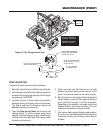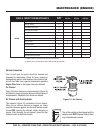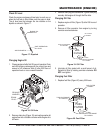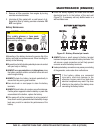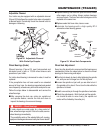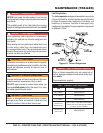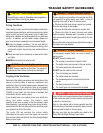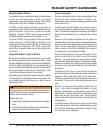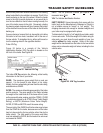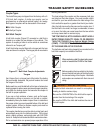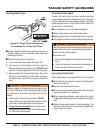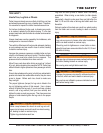
MQ62TDD TRASH PUMP • OPERATION AND PARTS MANUAL — REV. #0 (07/30/09) — PAGE 35
Reporting Safety Defects
If you believe that your vehicle has a defect that could cause
a crash or could cause injury or death, you should
immediately inform the National Highway Traffic Safety
Administration (NHTSA) in addition to notifying us.
If NHTSA receives similar complaints, it may open an
investigation, and if it finds that a safety defect exists in a
group of vehicles, it may order a recall and remedy
campaign. However, NHTSA cannot become involved in
individual problems between you, your dealer, or us.
To contact NHTSA, you may either call the Auto Safety
Hotline toll-free at 1-800-424-9393 (or 366-0123 in the
Washington D.C. area) or write to: NHTSA, U.S. Department
of Transportation, Washington, DC 20590. You can also
obtain other information about motor vehicle safety from
the Hotline.
Inoperable Brakes, Lights or Mirrors
Be sure that the brakes and all of the lights on your trailer
are functioning properly before towing your trailer. Check
the trailer taillights by turning on your tow vehicle headlights.
Check the trailer brake lights by having someone step on
the tow vehicle brake pedal while you look at trailer lights.
Do the same thing to check the turn signal lights. (See
Trailer Wiring Diagram section in this manual.)
Standard mirrors usually do not provide adequate visibility
for viewing traffic to the sides and rear a towed trailer. You
must provide mirrors that allow you to safely observe
approaching traffic.
TRAILER SAFETY GUIDELINES
WARNING — Checking Taillights/Brakelights
Improper electrical connection between the tow vehicle
and the trailer will result in inoperable lights and electric
brakes, and can lead to collision.
Before each tow:
Check that the taillights, brake lights and turn signals
work
Check that the electric brakes work by operating the
brake controller inside the tow vehicle
Trailer Towing Tips
Driving a vehicle with a trailer in tow is vastly different from
driving the same vehicle without a trailer in tow.
Acceleration, maneuverability and braking are all diminished
with a trailer in tow.
It takes longer to get up to speed, you need more room to
turn and pass, and more distance to stop when towing a
trailer. You will need to spend time adjusting to the different
feel and maneuverability of the tow vehicle with a loaded
trailer.
Because of the significant differences in all aspects of
maneuverability when towing a trailer, the hazards and risks
of injury are also much greater than when driving without a
trailer. You are responsible for keeping your vehicle and
trailer in control, and for all the damage that is caused if
you lose control of your vehicle and trailer.
As you did when learning to drive an automobile, find an
open area with little or no traffic for your first practice
trailering. Of course, before you start towing the trailer,
you must follow all of the instructions for inspection, testing,
loading and coupling. Also, before you start towing, adjust
the mirrors so you can see the trailer as well as the area to
the rear of it.
Drive slowly at first, 5 m.p.h. or so, and turn the wheel to
get the feel of how the tow vehicle and trailer combination
responds. Next, make some right and left hand turns.
Watch in your side mirrors to see how the trailer follows the
tow vehicle. Turning with a trailer attached requires more
room.
Stop the rig a few times from speeds no greater than 10
m.p.h. If your trailer is equipped with brakes, try using
different combinations of trailer/electric brake and tow
vehicle brake. Note the effect that the trailer brakes have
when they are the only brakes used. When properly
adjusted, the trailer brakes will come on just before the tow
vehicle brakes.
It will take practice to learn how to back up a tow vehicle
with a trailer attached. Take it slow. Before backing up, get
out of the tow vehicle and look behind the trailer to make
sure that there are no obstacles.



